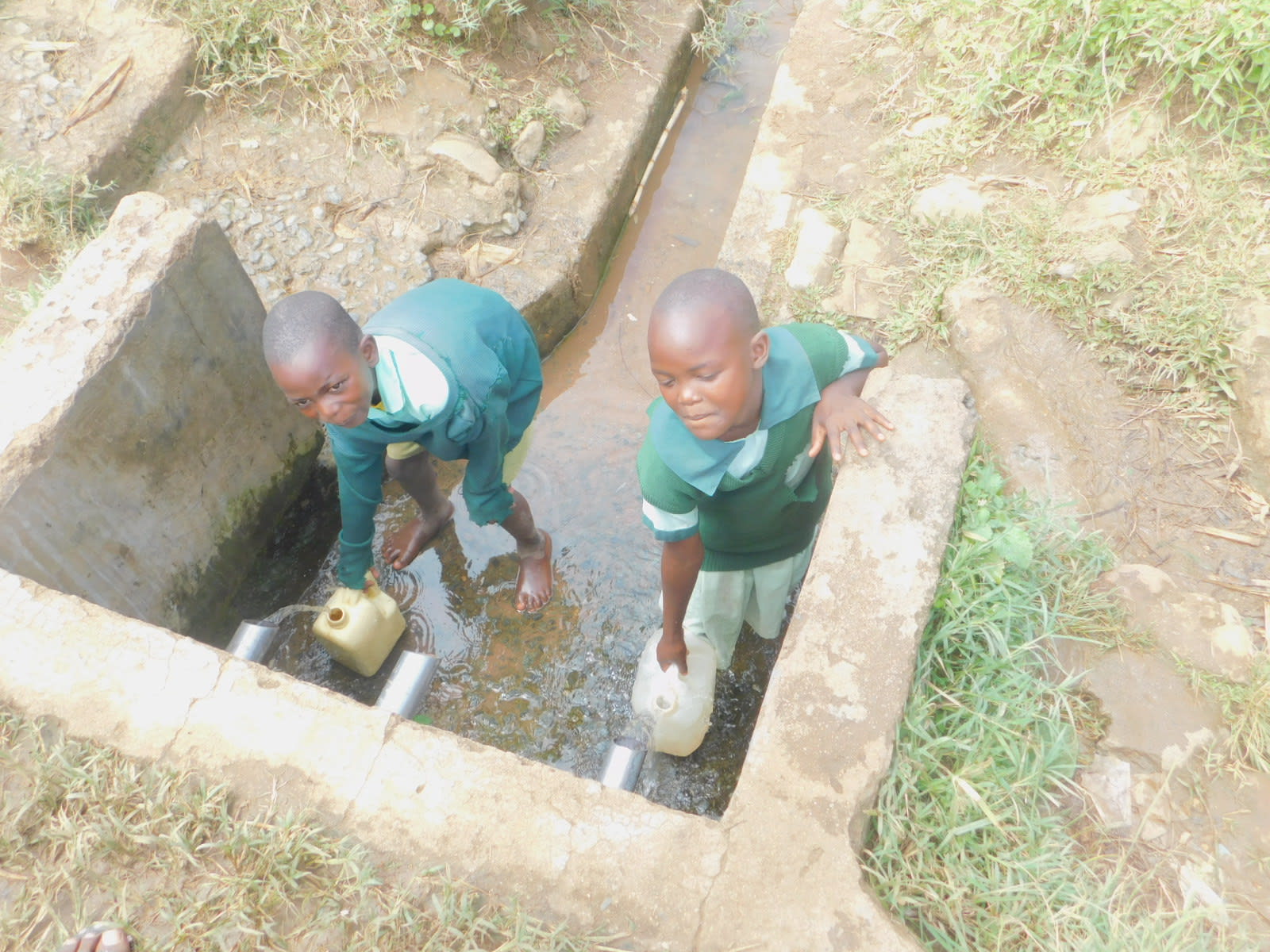September, 2019: Makunga Primary School Project Complete!
Makunga Primary School in Kenya now has access to a new source of safe, clean water thanks to the completion of their rain tank, which has the ability to collect 50,000 liters of water. We installed new latrines for students, handwashing stations, and we trained students and staff on improved sanitation and hygiene practices. All of these components work together to unlock the opportunity for these students to live better, healthier lives.

Rain Tank
Construction for this 50,000-liter rain tank was successful!
Parents, staff, and students helped our artisans gather everything needed for construction. All the while, women cooked meals for the artisans, and the school provided accommodations for the artisans during their work. Local women and men helped our artisans with their manual labor, too.

Preparing the site for the rain tank
The process officially began with our staff and school administration looking around the school compound to try and determine the best location for a new rain tank. This needed to be the best site with good, clean roofing to catch the rainwater.

Rain tank foundation
Then, we cleared the site: excavating the soil within the required measurements to make level ground for the tank foundation. The foundation was cast by laying hardcore on level ground and then reinforcing it using steel, concrete and waterproof cement.
Both the drawing pipe as well as the washout pipe were affixed as the foundation was laid. The wall was built with ferro-cement techniques through 6 layers. The inner wall was plastered while rough casting was done on the outer part. Finally, the catchment area was dug, plastered, and a staircase installed.

Working on the dome
Dome construction could begin after the superstructure had been given enough time to settle. The manhole cover was fitted, inlet pipes were connected to the roof gutters, inlet screens, ventilation pipes (breathers) and overflow pipes were all done to standard.

Adding the manhole cover to the rain tank
There were some challenges in the early days of the construction process, in which the school had difficulty obtaining enough laborers to help our artisan. They also lacked enough locally available materials at first, especially the sand, but all obstacles were overcome and we were able to complete the project successfully.

Once finished, the tank was given 3 to 4 weeks to undergo complete curing before it was cleaned and handed over to Makunga Primary School, though we will continue to offer them unmatchable support as a part of our monitoring and maintenance program.

The handing-over ceremony, with school staff in back and field staff in front
The celebration was a great chance for us to acknowledge the school administration and students as the primary parties entrusted with the tools we’ve given, as well as remind them of our continued support as they develop.
Both pupils and teachers were more than jovial on this happy occasion because of the new water point and VIP latrines at the school. Head Teacher Mrs. Gladys Mulinya invited students' parents to attend the handing over ceremonies, which were held at the school grounds. Parents also showed their smiling faces upon seeing the new water project at the school while students - both girls and boys - danced and sang to celebrate the projects and this momentous occasion.
One student, Triza Aura, even surprised her classmates and teachers by standing up to recite a poem she had written honoring the new facilities and our team (check out the video of her performance on the "Photos" tab for this project!). It was great fun watching everyone celebrate the presence of the new water tank.

''I thank you so much for installing a water tank in our school," said 13-year-old student Scarlet Nyakowa.
"We were suffering because we usually have morning preps but before going in for preps, we [would] rush to the spring to fetch water for drinking and kitchen use. But now we will be able to concentrate in class for preps without any water issue interference. Thank you once again, may God reward you."

Many pupils expressed similar sentiments about how pleased they were watching the tank's construction process and finally seeing it come to fruition. We heard how many students come to school on empty stomachs, so upon arriving at school when they were sent to fetch water at the spring they became exhausted. At least now, they would not be sent to the spring and they would not become so tired anymore.

VIP Latrines
This project funded the installation of 6 new ventilated improved pit (VIP) latrines, half for girls and half for boys. All of these new latrines have cement floors that are designed to be easy to use and clean. And with a rain tank right on school property, there should be enough water to keep them clean.

Girls in front of their new latrines
''As a sanitation and hygiene teacher, I would like to say may Almighty God shower you and your donors with much blessings, for really you have saved us so much in terms of water and VIP latrines," said Madam Jacklyne.
"Especially in [the] girls' section [of students], we have many girls and to be sincere [our] girls latrines were almost filling up and the school had no any way of constructing new ones...you have come at the right time to save us, it was very pathetic on [our] girls' side'."

Boys in front of their new latrines
Handwashing Stations
The 2 handwashing stations were delivered to the school and handed over to the Child to Child health club. These were placed outside of the girls’ and boys’ latrines to encourage handwashing after latrine use.

Health club members teach other students how to properly wash their hands at the stations, make sure the stations are filled with water and work to ensure that there is always soap or ash available.
New Knowledge
Hygiene and sanitation training was scheduled with the help of the school principal and Head Teacher Mrs. Gladys Mulinya, who ensured that the training date would be convenient for students, staff, and parent representatives. Individual teachers helped by selecting students from each class to represent the others.

A student reacts during training
On the day of the training, it was sunny and the training was not affected in any way, weather or otherwise. This is because we met in a cool classroom and outside behind that classroom it was surrounded by trees which made the room cool and conducive for learning. 28 pupils attended. All the attendees were involved and participated equally, asking and answering questions all day.

Trainer Jacky in action
We covered a number of topics, including personal hygiene such as bathing, oral hygiene, and handwashing with soap as a barrier from germs; and operation and maintenance of the new facilities, with each person understanding their role for long-lasting clean water and good health. The new student health club will be greatly involved in project management and will be responsible for encouraging good health and hygiene practices amongst their peers, teachers, and the larger community.
The participants seemed to be very interested in leadership and governance. They were very involved and wanted to know exactly what kind of leaders they were to choose to lead their student health club. The trainer divided the students into 3 groups to discuss different kinds of animals and their characters, relating them to the kinds of leaders they might need.
When the students heard of animals like a hyena and its associated character they laughed out loud and said they did not want to have leaders who have such characters. After this special moment, through group discussion, the participants were able to identify the kind of club leaders they wanted and elected their peers to the positions.

Handwashing training
When we covered the 10 handwashing steps, we first asked students to demonstrate how they usually wash their hands. Then we demonstrated all of the steps. This was special to the attendees since they were not used to the full handwashing process and they did not know that after washing their hands they should not wipe their hands with anything to dry them. This allows their hands to dry germ-free. This made the students happy and they promised to practice it even at home.

''This training will help us improve on our sanitation and hygiene," said 16-year-old student Daniel Makokha.
"We have learned things that we didn't know, [and now] we will be able to overcome some diseases like cholera, typhoid, and diarrhea. This is because [before], we could not wash our hands after visiting the latrine or whenever we came across something to [eat].'
Thank you for making all of this possible!



 Rainwater Catchment
Rainwater Catchment
 Rehabilitation Project
Rehabilitation Project







































